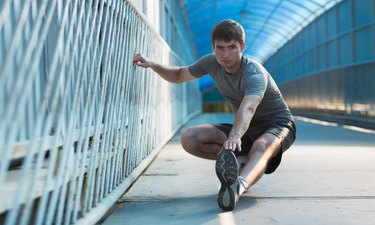
Hamstring inflexibility can be caused by many things; not the least of which is a sedentary lifestyle. In addition, if you work in an office and are stuck sitting at a desk all day, your hamstrings will become short and tight without regular stretching and lengthening. Inflexibility also increases injury potential as well as muscle spasms and strains in the lower back.
Function of the Hamstrings
Video of the Day
The hamstring consists of three muscles: the biceps femoris, semitendinosus and semimembranosus, that originate underneath the gluteus maximus, run along the back of your thighs or femur bone, cross at the knee joint and attach to your tibia. The primary functions of the hamstring muscle are knee flexion, hip extension and external and internal rotation of the legs.
Video of the Day
The hamstring muscles promote trunk stability and hip extension by bringing the femur bone backward in relation to the pelvis. During movements such as walking or running, the hamstring muscles contract and propel you forward by extending the hip and bringing the femur or thigh bone back in a backward-bending motion. During the next forward step, the hamstring muscles contract and bend the knees.
The hamstrings also stabilize the pelvis by tilting it back. The contraction of these muscles counteracts the pulling action of the lower abdominal and back muscles that tilt the pelvis forward.
Read more: Hamstring Strengthening Exercises at Home
Cause of Hamstring Inflexibility
Hamstring inflexibility is often the result of muscle weakness or instability in another part of the body. The hamstring muscles stabilize the pelvis by providing a counteractive force to the forward pull on the pelvis by the abdominal and lower back muscles.
If your lower-abdominal or lower-back muscles are unstable or weak, they can't provide the force to counteract the backward-bending pull on your pelvis. As a result, the hamstring muscles tighten and shorten as they continue to pull and tilt the pelvis backward.
Wearing shoes with high or cushioned heels put you at greater risk of hamstring inflexibility. These types of shoes shift your hips forward and causes the knee to hyperextend. This places an excess amount of strain and tension on the hamstring with each contraction.
The continuous contraction and tension causes the hamstring muscles to tighten and become inflexible. You may also have inflexible hamstrings as a result of overusing these muscles in sports that require a lot of running, scar tissue or not properly stretching before a sporting activity.
Potential Problems
Diminished flexibility in the hamstrings increases your injury potential since tight muscles are susceptible to tears and strains. When your hamstrings are tight or under tension, they pull the pelvis and lumbar region of the spine away from the saggital plane. This tilts your pelvis farther back, contributing to lower back pain, muscle spasms and postural problems.
Tight hamstrings also compromise your performance in sports by limiting the range of movement in your pelvis and hips, thereby altering your form and stride length in sports that require power, agility and speed. Tight hamstring increase your risk for hip and knee injuries since the muscle cannot relax, as it's meant to, in movement where the hip joint is bent and the thigh is lifted.
Testing Your Hamstrings
Check your range of hip flexion by lying flat on your back on a firm surface. Straighten your knees and lift one leg at a time straight up to the ceiling. The normal range of motion for hip flexion is 80 to 90 degrees and anything less is a result of tightness in your hamstrings.
If you experience tightness in your hamstrings begin with gentle stretching and strengthening exercises to restore flexibility to your hamstrings and reduce your injury potential.
Begin with dynamic warm-up exercises to actively engage the your thigh, hip and hamstring muscles and increase the circulation of oxygenated blood and nutrients to these areas. Increased circulation makes the muscles more elastic and helps to elongate them, alleviating muscle inflexibility.
Read more: Top 10 Hamstring Exercises With No Weight